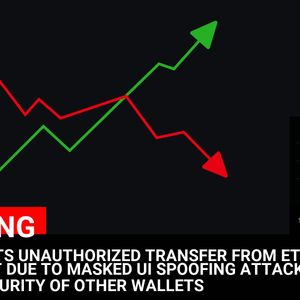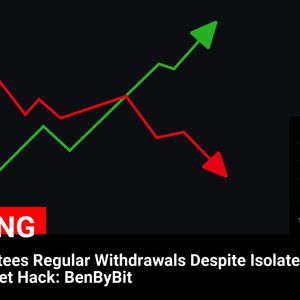The cryptocurrency realm continues to navigate a peculiar phase, characterized by sideways trading that seems detached from the usual macroeconomic triggers. Despite data releases and global economic shifts, the crypto market, particularly Bitcoin, is charting its own course. Let’s delve into the current market dynamics, as analyzed by Singapore-based crypto trading firm QCP Capital, and understand what these trends signify for investors and traders alike. Understanding the Sideways Trading in the Crypto Market According to QCP Capital, the crypto market has been exhibiting a persistent sideways trading pattern. This means that instead of sharp upward or downward movements, prices are largely fluctuating within a defined range. This behavior suggests a period of consolidation and indecision among market participants. Several factors could contribute to this: Macroeconomic Disconnect: Traditionally, financial markets, including crypto, react to macroeconomic data releases like inflation figures, employment rates, and GDP growth. However, the current sideways trading indicates a reduced sensitivity to these factors, at least in the short term. Market Indecision: The lack of a clear directional trend suggests that the market is waiting for a significant catalyst to break out of its current range. This could be regulatory clarity, technological breakthroughs, or shifts in institutional adoption. Range-Bound Trading Strategies: As QCP Capital points out, traders are primarily engaged in “near dated vol selling” and “range trading.” This means they are capitalizing on short-term volatility within the existing range rather than betting on a major breakout. Bitcoin Dominance: A Key Indicator Amidst the sideways shuffle, a significant trend is emerging: Bitcoin dominance is on the rise, reaching approximately 60%. Bitcoin dominance refers to the ratio of Bitcoin’s market capitalization to the total cryptocurrency market capitalization. A rising Bitcoin dominance suggests: Flight to Safety: In times of market uncertainty or sideways movement, investors often gravitate towards Bitcoin, perceived as the most established and secure cryptocurrency. This “flight to safety” phenomenon can boost Bitcoin’s dominance. Altcoin Underperformance: Conversely, a rise in Bitcoin dominance can also indicate that altcoins (alternative cryptocurrencies) are underperforming Bitcoin. This could be due to various factors, including increased regulatory scrutiny on altcoins or a shift in investor focus back to Bitcoin’s core value proposition. Market Sentiment Gauge: Bitcoin dominance can serve as a barometer of overall market sentiment. A sustained increase might signal a cautious or risk-off environment, while a decrease could indicate a renewed appetite for riskier altcoin investments. The growing Bitcoin dominance warrants close attention as it can influence broader market trends and investment strategies. Crypto Options Market: Waiting for Policy Shifts The crypto options market provides further insights into the current market sentiment. According to QCP Capital, Bitcoin (BTC) options open interest has not shown a substantial recovery after the January month-end expiry. This stagnation suggests that the options market is not reacting to mere pro-crypto rhetoric, such as positive statements from political figures. Instead, it’s waiting for concrete policy changes. This implies: Policy-Driven Market: The crypto options market is becoming increasingly sensitive to regulatory and policy developments. Traders are likely holding back from making significant directional bets until there is more clarity on the regulatory front. Beyond Rhetoric: Positive pronouncements or verbal support for crypto may not be sufficient to trigger significant market movements. Concrete policy changes, such as clearer regulations or favorable legal frameworks, are needed to instill confidence and drive substantial investment. Institutional Hesitation: The cautious stance in the options market could also reflect institutional investors’ hesitation to fully engage with crypto until regulatory uncertainties are addressed. The subdued activity in the crypto options market highlights the critical role of policy in shaping the future trajectory of the cryptocurrency industry. Market Volatility: Echoes of the Past Market volatility , a measure of price fluctuations, is currently at levels reminiscent of Q2 and Q3 of the previous year. During that period, Bitcoin struggled to break out of a multi-month trading range. This comparison to past volatility levels is crucial because it suggests: Established Range: The current volatility levels reinforce the notion of a defined trading range for Bitcoin. Similar to the Q2-Q3 period, Bitcoin may remain confined within this range until a significant catalyst emerges. Predictable Trading Patterns: The repetition of volatility patterns from the past can offer insights into potential future price movements. Traders can draw parallels and adjust their strategies accordingly, focusing on range trading rather than expecting immediate breakouts. Patience Required: For investors anticipating substantial price appreciation, the current volatility levels suggest that patience is key. The market may require time to consolidate and build momentum before a significant upward trend can materialize. Navigating Sideways Trading: Actionable Insights So, how can traders and investors navigate this phase of sideways trading and growing Bitcoin dominance? Here are some actionable insights: Range Trading Strategies: Focus on strategies that capitalize on price fluctuations within the established range. This includes buying at support levels and selling at resistance levels. Monitor Bitcoin Dominance: Keep a close watch on Bitcoin dominance as it can provide clues about overall market sentiment and potential shifts in capital allocation between Bitcoin and altcoins. Policy Tracking: Stay informed about regulatory developments and policy changes that could impact the crypto market. These factors are likely to be significant catalysts for future market movements. Risk Management: In a sideways market, risk management is paramount. Avoid over-leveraging and ensure your portfolio is well-diversified to mitigate potential downside risks. Patience and Long-Term Vision: Recognize that sideways trading is a phase in the market cycle. Maintain a long-term perspective and avoid making impulsive decisions based on short-term price fluctuations. Conclusion: The Crypto Market’s Waiting Game The cryptocurrency market is currently in a state of pause, characterized by sideways trading and increasing Bitcoin dominance. While macroeconomic factors seem to have taken a backseat for now, the market is keenly awaiting policy signals and concrete regulatory changes. The crypto options market’s subdued activity and volatility levels reminiscent of past range-bound periods further reinforce this narrative of a market in anticipation. For investors and traders, navigating this phase requires a strategic approach focused on range trading, vigilant monitoring of Bitcoin dominance and policy developments, and above all, patience. The market’s next significant move will likely be dictated by external catalysts, particularly in the realm of policy and regulation. To learn more about the latest crypto market trends, explore our article on key developments shaping Bitcoin price action.



















